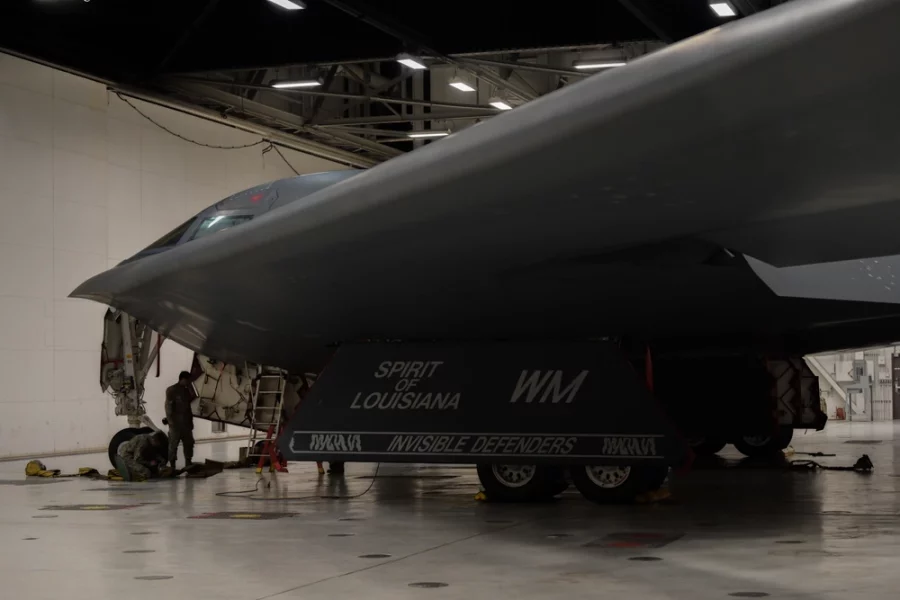After the Air Force recently revealed it will divest one of its 20 remaining B-2 bombers, deeming it uneconomical to fix after a December 2022 mishap, a service spokesperson said the projected savings associated with the move—some $176 million in operations and maintenance over the next five years—won’t be poured into the rest of the fleet.
That stands in contrast to what the Air Force did three years ago when it retired 17 of its 62 B-1 bombers. Rather than cut the B-1’s O&M funding, the service used the freed-up dollars to increase the Lancer’s availability.
“The fiscal year 2025 budget request invests in both building upon our modernization efforts and resourcing readiness,” a spokesperson told Air & Space Forces Magazine. “Potential savings in some areas”—including B-2 O&M—“must be managed at the enterprise level to account for increased costs in others to support National Defense Strategy priorities, which include defending the homeland, deterring strategic attacks, deterring aggression and building a resilient joint force.”
“We take a holistic view when developing the budget,” another spokesperson said.
The availability and remaining service life for both the B-1 and B-2 fleets are the source of much speculation as the Air Force has been cagey with details while it plans out the transition to the new B-21 Raider.
The spokesperson did say both the B-1 and B-2 fleets will be gradually drawn down as the inventory of B-21s increases, seemingly ruling out any mass retirements of B-2s or B-1s as fresh aircraft become operational.
Asked if the start of flight testing on the first B-21 coinciding with the divestment of the first B-2 indicates the Spirit will retire on a one-for-one basis as Raiders enter the inventory, the spokesperson said “the Air Force will incrementally retire existing B-1 and B-2 aircraft as B-21s come on line. For operational security reasons, we are not going to get into specifics.”
According to an April force structure report issued by the Pentagon, the Air Force stands to save $176 million in O&M and $34 million in associated personnel costs through fiscal 2029 by retiring just one B-2: more than $210 million total.
However, the spokesperson said no decision has been made about how much to cut or move the manpower footprint associated with the aircraft.
“The Fiscal Year 2025 budget request will divest one B-2,” the spokesperson said. “That divestment will reduce requirements for certain depot maintenance and contractor logistics support functions, but specific changes to manpower authorizations will be decided at a later time.”
The second spokesperson clarified that even though the condemned aircraft wasn’t considered part of the fleet when the 2025 budget was built, “it does not mean we were already planning to divest a B-2.”
The B-21’s first operating station will be at Ellsworth Air Force Base, S.D., where military construction to prepare for the new bomber has been underway for some time. The Air Force has previously said that manpower billets will shift from the B-1 and B-2 to B-21 as the latter program matures. The service has also said that the first B-21 test aircraft will be “usable assets” for combat “in the mid-2020s.”
The Air Force recently awarded an indefinite delivery/indefinite quantity contract worth up to $7 billion to B-2 prime Northrop Grumman for depot and line maintenance to carry the B-2 fleet through to its retirement. Although the Air Force has been unclear about when exactly the B-2 fleet will be completely retired, the contract—as well as future years defense plan estimates for B-2 research and development and procurement—end in fiscal 2028.
The service declined to say how much it would cost to fix the damaged B-2 and bring it back into service, citing the “ongoing accident investigation.” For similar reasons, it won’t discuss the specific damages sustained by the mishap airplane.
After a B-2 was badly damaged in a 2010 accident at Andersen Air Force Base, Guam, the Air Force said it couldn’t bear to lose even one B-2 from the inventory and undertook a repair effort that cost more than $100 million over four years. If the late 2022 mishap aircraft needed a similar repair time, it would likely serve only two years or so before the B-2 fleet is retired, potentially explaining why the Air Force has decided not to fix it.
Counting aircraft in depot, maintenance and test, the divestment of another B-2—the second lost out of an original fleet of 21—means the Air Force has about 13 of the bombers available for combat at any time.
